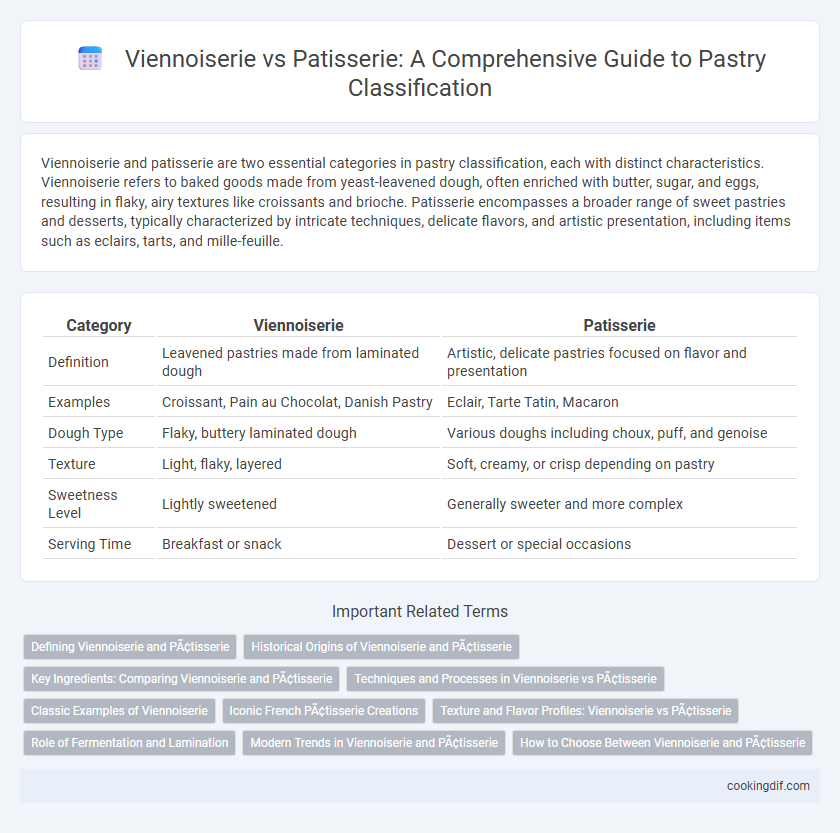Viennoiserie and patisserie are two essential categories in pastry classification, each with distinct characteristics. Viennoiserie refers to baked goods made from yeast-leavened dough, often enriched with butter, sugar, and eggs, resulting in flaky, airy textures like croissants and brioche. Patisserie encompasses a broader range of sweet pastries and desserts, typically characterized by intricate techniques, delicate flavors, and artistic presentation, including items such as eclairs, tarts, and mille-feuille.
Table of Comparison
| Category | Viennoiserie | Patisserie |
|---|---|---|
| Definition | Leavened pastries made from laminated dough | Artistic, delicate pastries focused on flavor and presentation |
| Examples | Croissant, Pain au Chocolat, Danish Pastry | Eclair, Tarte Tatin, Macaron |
| Dough Type | Flaky, buttery laminated dough | Various doughs including choux, puff, and genoise |
| Texture | Light, flaky, layered | Soft, creamy, or crisp depending on pastry |
| Sweetness Level | Lightly sweetened | Generally sweeter and more complex |
| Serving Time | Breakfast or snack | Dessert or special occasions |
Defining Viennoiserie and Pâtisserie
Viennoiserie refers to a category of baked goods that blend elements of pastry and bread, characterized by their flaky, buttery, and often laminated doughs such as croissants and brioche. Patisserie encompasses a broader range of delicate French desserts and pastries, made with refined doughs or batters, including eclairs, tarts, and mille-feuille, often featuring rich creams and intricate decoration. The primary distinction lies in Viennoiserie's bread-like texture and buttery layers versus Patisserie's emphasis on sweetness, complex fillings, and artistic presentation.
Historical Origins of Viennoiserie and Pâtisserie
Viennoiserie originated in Austria during the 18th century, gaining popularity in France through the introduction of the kipferl, an early form of the croissant. Patisserie, rooted in French culinary tradition, developed from medieval times with intricate techniques focused on cakes, tarts, and elaborate desserts. Both categories reflect distinct historical influences: Viennoiserie merges Austrian baking methods with French refinement, while patisserie embodies centuries of French artistry in sweet pastry creation.
Key Ingredients: Comparing Viennoiserie and Pâtisserie
Viennoiserie typically relies on laminated dough enriched with butter, eggs, and sugar, creating a flaky, airy texture, while patisserie often uses a variety of doughs like pate sucree or pate sablee combined with creams, fruits, and custards for complex flavors. The high butter content in viennoiserie doughs such as croissants distinguishes them from patisserie items like tarts and eclairs, which focus more on fillings and decorative elements. Sugar and eggs are essential in both classifications but are incorporated differently to achieve distinct textures and taste profiles.
Techniques and Processes in Viennoiserie vs Pâtisserie
Viennoiserie involves laminated dough techniques like folding and layering butter to create flaky, airy textures, exemplified in croissants and pain au chocolat. Patisserie focuses on precise mixing, baking, and assembling delicate pastries such as eclairs and tarts, emphasizing creams, custards, and decorative finishing. Both disciplines require distinct mastery of ingredients and temperature control to achieve their characteristic textures and flavors.
Classic Examples of Viennoiserie
Classic examples of viennoiserie include croissants, pain au chocolat, and brioche, characterized by their flaky, buttery layers achieved through laminated dough techniques. Unlike patisserie, which focuses on elaborate cakes and pastries often filled with creams and fruits, viennoiserie emphasizes rich, yeast-leavened baked goods with a tender texture. These items are typically consumed at breakfast or as snacks, showcasing a distinct balance between bread and pastry elements.
Iconic French Pâtisserie Creations
Iconic French patisserie creations such as eclair, mille-feuille, and tarte Tatin emphasize delicate technique and intricate flavor profiles, highlighting refined pastry doughs like pate a choux and puff pastry. Viennoiserie, including croissants, pain au chocolat, and brioche, focuses on laminated doughs enriched with butter and yeast, delivering a flaky, airy texture with a sweet, buttery taste. Both categories showcase French artistry in pastry but differ primarily in dough preparation and texture, with patisserie leaning toward dessert refinement and viennoiserie offering breakfast indulgence.
Texture and Flavor Profiles: Viennoiserie vs Pâtisserie
Viennoiserie features a flaky, buttery texture with rich, sweet flavors often enhanced by yeast fermentation, resulting in airy and tender pastries like croissants and brioche. Patisserie offers a broader range of textures from crisp and delicate to creamy and dense, with complex flavor profiles balancing sweetness, fruitiness, and sometimes subtle bitterness, exemplified by eclairs and tarts. The emphasis on layered, laminated dough defines Viennoiserie, while Patisserie prioritizes intricate craftsmanship in fillings and decorative elements.
Role of Fermentation and Lamination
Viennoiserie and patisserie differ significantly in their use of fermentation and lamination, impacting texture and flavor. Viennoiserie, such as croissants and brioche, relies on yeast fermentation for leavening and incorporates lamination through layers of butter and dough to create a flaky, airy structure. Patisserie focuses more on non-leavened or chemically leavened doughs and emphasizes precision in techniques like creaming and folding without the layered lamination characteristic of viennoiserie.
Modern Trends in Viennoiserie and Pâtisserie
Modern trends in Viennoiserie showcase innovative use of artisanal techniques combined with global flavors, emphasizing laminated doughs enriched with unique fillings such as matcha, yuzu, and salted caramel. Patisserie continues to evolve with intricate, visually stunning designs and a focus on refined pastry creams, fruit gels, and gluten-free, vegan options to meet contemporary dietary preferences. Both sectors increasingly prioritize sustainability and locally sourced ingredients, reflecting consumer demand for ethical and high-quality products.
How to Choose Between Viennoiserie and Pâtisserie
Choosing between Viennoiserie and Patisserie hinges on the desired texture and sweetness level; Viennoiserie, characterized by laminated doughs like croissants and brioche, offers a flaky, buttery experience, whereas Patisserie encompasses a broader range of pastries, including tarts, eclairs, and mousses, often focusing on delicate flavors and intricate decorations. Consider the occasion and flavor profile: Viennoiserie suits breakfast or casual snacks with its rich, airy layers, while Patisserie is ideal for celebratory desserts and refined presentations. Understanding these distinctions helps in selecting pastries that match taste preferences and event contexts effectively.
Viennoiserie vs Pâtisserie for pastry classification Infographic

 cookingdif.com
cookingdif.com